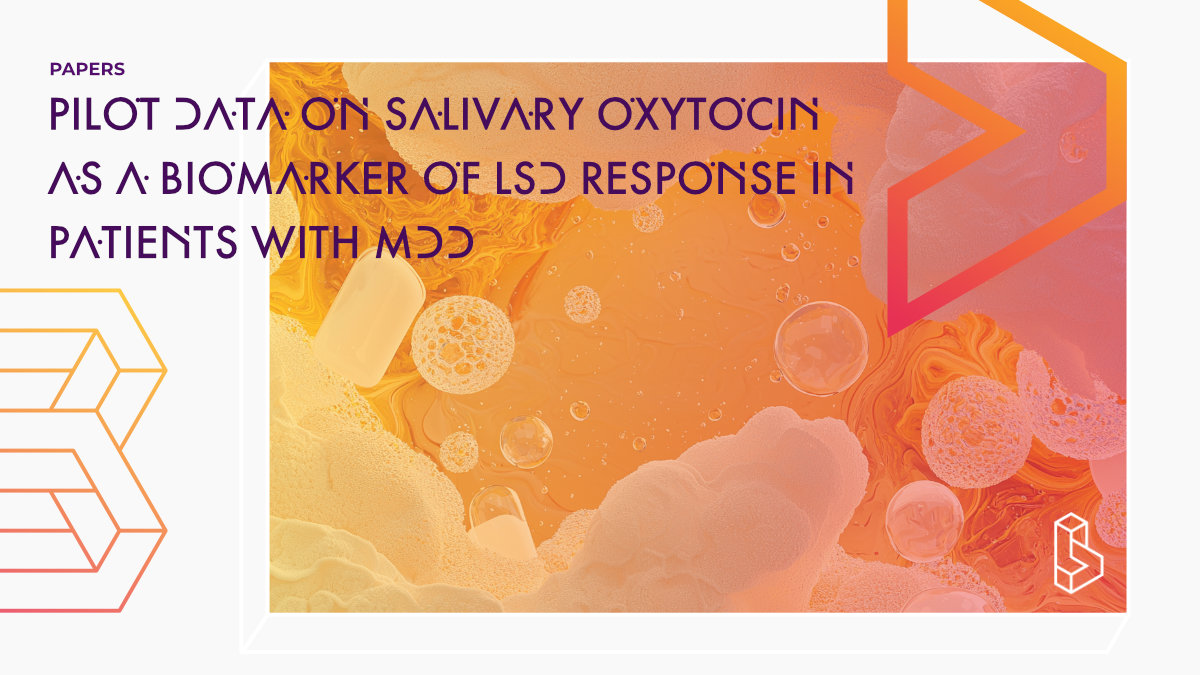This pre-print reports an observational pilot study (n=12) examining salivary oxytocin (‘love/bonding hormone’) dynamics during LSD-assisted psychotherapy (100-150μg) for treatment-resistant depression (TRD), finding significant time-dependent variations in both oxytocin levels and subjective drug intensity ratings, suggesting oxytocin may serve as a potential biomarker for psychedelic therapy.
Abstract of Pilot Data on Salivary Oxytocin as a Biomarker of LSD Response in Patients with Major Depressive Disorder
“Despite growing evidence supporting the efficacy of LSD‐assisted psychotherapy in treating major depressive disorder (MDD), identifying reliable psychopharmacological biomarkers remains necessary. Oxytocin, a neuropeptide implicated in social bonding and flexibility, is a promising candidate due to its release following serotonergic psychedelic administration in healthy individuals; however, its dynamics in psychiatric populations are currently unexplored. This observational pilot study aimed to characterize salivary oxytocin dynamics during a single LSD‐assisted psychotherapy session in our patients with treatment‐resistant MDD. Participants received 100 or 150 μg LSD and salivary oxytocin was measured at baseline, 60, 90, and 180 minutes post‐LSD. Concurrently, participants rated subjective drug intensity (0‐10 scale) at 60, 90, and 180 minutes. A linear mixed model revealed significant variation of oxytocin levels over time. Perceived psychedelic intensity also significantly varied over time. This supports oxytocin as a potential biomarker. Larger, controlled trials are warranted to replicate these findings and clarify mechanistic links between oxytocin dynamics and clinical outcomes, including changes in depressive symptoms and mental flexibility.“
Authors: Laurie Cazorla, Sylvie Alaux, Caroline Amberger, Cédric Mabilais, Leonice Furtado, Albert Buchard, Gabriel Thorens, Louise Penzenstadler, Daniele Zullino & Tatiana Aboulafia‐Brakha
Summary of Pilot Data on Salivary Oxytocin as a Biomarker of LSD Response in Patients with Major Depressive Disorder
Despite mounting evidence that LSD-assisted psychotherapy may be effective in treating major depressive disorder (MDD), there remains a need to identify reliable biomarkers to predict or measure treatment response. LSD (lysergic acid diethylamide), a classical psychedelic compound, works primarily through activating 5-HT₂A receptors—a type of serotonin receptor in the brain. This activation triggers a cascade of neurochemical events, including the release of oxytocin, a neuropeptide associated with social bonding, emotional regulation, and psychological flexibility.
The concept of flexibility—specifically mental or cognitive flexibility—is increasingly regarded as a critical mechanism by which psychedelic substances exert therapeutic effects in mood disorders. Identifying measurable biological markers, or “biomarkers,” that reflect this process is a central goal in psychedelic research. According to definitions from the National Institutes of Health and the FDA, biomarkers are objectively measured characteristics that reflect biological states or responses to interventions. These can be categorised as pharmacodynamic biomarkers, which indicate how a drug is acting in the body, or predictive biomarkers, which identify individuals likely to benefit from treatment.
To be useful in clinical research, biomarkers must be both reliable and easy to measure. Non-invasive sampling methods like saliva collection offer practical advantages, especially in vulnerable populations. In prior studies involving healthy individuals, oxytocin levels in the blood have been shown to rise 90–180 minutes after LSD administration. Similar findings have emerged in rodent models using LSD-like compounds, where these effects were blocked by antagonists targeting the 5-HT₂A receptor. However, no studies had yet explored oxytocin dynamics in psychiatric populations undergoing psychedelic treatment—nor had salivary oxytocin levels been studied during LSD sessions. This study aimed to fill that gap by examining salivary oxytocin responses in patients with treatment-resistant MDD receiving LSD under a compassionate-use programme.
Materials and Methods
Design and Setting
Find this paper
https://doi.org/10.20944/preprints202506.0395.v2
Open Access | Google Scholar | Backup | 🕊
Cite this paper (APA)
Cazorla, L., Alaux, S., Amberger, C., Mabilais, C., Furtado, L., Buchard, A., ... & Brakha, T. A. (2025). Pilot Data on Salivary Oxytocin as a Biomarker of LSD Response in Patients with Major Depressive Disorder.
Study details
Compounds studied
LSD
Topics studied
Depression
Treatment-Resistant Depression
Neuroscience
Study characteristics
Original
Open-Label
Bio/Neuro
Participants
12
Humans
Compound Details
The psychedelics given at which dose and how many times
LSD 100 - 150μg | 1x
Linked Clinical Trial
Salivary Oxytocin as a Biomarker in Psychedelic Assisted Psychotherapy (PAP_OXT)This observational pilot study (n=10) will investigate the reactivity of salivary oxytocin during a single dose of lysergic acid diethylamide (LSD) as part of psychedelic-assisted psychotherapy (PAP) for anxiety disorders or depression.

